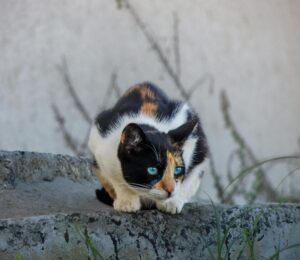Cats are known for their love of napping. This article explores the “cat nap,” including the feline sleep cycle and its benefits. It also shows how to create the best environment for your cat to nap.
Cats can fall asleep anywhere, from sunny windowsills to plush beds. These short naps are crucial for their energy and health. This article will help you understand and support your cat’s napping habits.
Table of Contents
Understanding the Feline Sleep Cycle
Cats sleep in a unique way, known as polyphasic. They take many short naps during the day and night. Knowing how cats sleep helps us see why their naps are so important.
Polyphasic Sleep Pattern
Cats sleep in short bursts all day and night. Unlike humans, who sleep for one long time, cats nap up to 20 times a day. Each nap is short, from a few minutes to hours. This helps them stay alert and ready to hunt.
Importance of Napping
Napping is key for cats. These short rests give them energy for play, hunting, or exploring. By napping often, cats stay alert and ready for anything.
Napping has many benefits for cats, like saving energy and keeping their minds sharp. Learning about cat sleep patterns helps us make their lives better. It ensures they get the rest they need.
Cozy Napping Spots for Cats

Cats are experts at finding the best spot to nap. They look for places that are both comfy and safe. Knowing what your cat likes can help make their sleep area better.
A sunny windowsill is a favorite cat napping spot. Cats enjoy the warmth and breeze. Adding a cat bed or cushion makes it even more inviting.
- Elevated spots like shelves or cat trees give cats a view and feel safe. They’re great cat napping spots.
- Cozy corners under furniture or in quiet spots are perfect for cats who like privacy. They’re great cat napping spots.
- Many cats like comfortable cat beds in quiet areas. They offer a place to relax without being disturbed.
It’s important to give your cat different places to nap. This way, they can find their favorite spot and nap peacefully.
The Art of Cat Nap
Cats are experts at napping. They can nap in many ways, like the “loaf” or “sploot” positions. These positions show how they feel. Also, how long and deep a cat naps can change, from light to very deep.
Positions and Postures
Cats nap in many ways, showing their comfort and calm. The “loaf” position means they’re very relaxed. The “sploot” shows they’re in a deep sleep. Other napping styles include the “meatloaf,” “pretzel,” and “sphinx,” each showing a cat’s favorite way to nap.
Duration and Depth
The length and depth of a cat’s nap can change. It depends on their energy, age, and health. Some cats nap lightly, while others nap deeply, showing they’re really resting.
“Cats have one of the most efficient sleep cycles, allowing them to recharge and conserve energy throughout the day.”
Knowing how cats nap can help us understand their needs. It helps us make their living space more comfortable and supportive.
Benefits of Napping for Cats
Cats love to nap, and it’s not just a funny habit. There are real benefits to their naps. They get to save energy and feel mentally refreshed.
Energy Conservation
Cats are natural hunters, needing quick energy for hunting and play. But these activities can wear them out. By napping often, cats keep their energy up for when they need it most. It’s like a recharge for their next adventure.
Mental Rejuvenation
Napping also helps cats’ minds. These short rests help them feel better and think clearer. Just like us, cats need time to relax and think about their day, and naps are perfect for that.
So, napping is good for cats in many ways. It helps them save energy and feel mentally sharp. By understanding this, we can see how important naps are for their health and happiness.
Signs of a Deep Cat Nap
Knowing if your cat is in a deep sleep can tell you a lot about their health. By watching for physical signs, you can see if they’re really resting well.
One clear sign is slow, deep breathing. Cats breathe more smoothly when they’re deeply asleep. You’ll also see their muscles are completely relaxed, without any movement.
- Lack of responsiveness to external stimuli
- Uninterrupted, prolonged sleeping periods
- Slow, steady heartbeat
- Curled-up, compact body posture
Another sign is not reacting to things around them. Cats usually wake up easily, but a deep sleeper won’t. This shows they’re really resting.
| Signs of a Deep Cat Nap | Explanation |
|---|---|
| Slow, deep breathing | Rhythmic and less erratic respiration |
| Relaxed muscles | No visible twitching or fidgeting |
| Lack of responsiveness | Unaffected by minor external stimuli |
| Prolonged sleeping periods | Uninterrupted, extended nap sessions |
| Curled-up posture | Compact, relaxed body position |
Learning these signs helps you understand your cat’s sleep better. It ensures they get enough rest to stay healthy.
Creating a Nap-Friendly Environment
To support your cat’s natural napping habits, it’s key to make your home cat nap-friendly. You need to offer various optimal cat nap locations and comfortable cat napping spots around your home.
Quiet and Comfortable Spaces
Cats love quiet, peaceful spots. Look for cozy corners or secluded areas in your home for your cat to nap. Place soft, plush cat beds or cushions in these spots to help them relax and nap without interruption.
Elevated Perches and Beds
Cats like to nap high up, where they can watch their surroundings and feel safe. Set up cat trees, window perches, or elevated cat beds for your cat to nap comfortably. These optimal cat nap locations will make your cat feel secure and happy while they nap.
- Put cat trees or window perches in sunny spots with little foot traffic.
- Get elevated cat beds that are cozy and comfy for your cat to nap on.
- Make sure comfortable cat napping spots are easy to get to and away from noise.
By making your home cat nap-friendly with quiet, comfy spots and high places, you help your cat nap well. This lets them enjoy the many benefits of cat naps.
Respecting Your Cat’s Nap Time
Cats love to nap a lot, spending a big part of their day sleeping. It’s key to letting cats nap and not disturbing cat naps. This helps keep them happy and healthy, and makes your bond with them stronger.
Cats are very sensitive to their surroundings. Waking them up can really upset them. It might even cause bad behavior or health issues. So, it’s very important to respect their importance of cat nap time. This lets them get the rest they need to stay physically and mentally sharp.
- Avoid making loud noises or sudden movements near a sleeping cat.
- Refrain from trying to wake a napping cat unless it is absolutely necessary.
- Provide a quiet, comfortable, and undisturbed space for your cat to enjoy their nap.
- Respect your cat’s nap time by allowing them to wake naturally, without interruption.
By letting your cat nap, you build a strong and loving bond with them. A well-rested cat is a happy and healthy cat. Your care and understanding will make a big difference in their happiness and health.
“Let sleeping cats lie – they know their bodies and minds better than we do.”- Unknown

Cat Nap and Aging
As cats get older, their sleep habits change a lot. Cat napping and aging are closely linked. Senior cats often need more sleep to stay healthy.
Older cats tend to nap more during the day. They might struggle to stay awake, so they nap more. This is a natural part of aging.
Senior cats also like to nap for longer. Unlike younger cats, they prefer longer, uninterrupted sleeps. This helps them feel refreshed.
It’s important for cat owners to understand these changes. By creating a nap-friendly environment and letting them rest, we help our older cats. This ensures they get the care they need as they age.
“As cats grow older, their napping patterns can undergo significant changes, reflecting their evolving physiological and psychological needs.”
By paying attention to these changes, we can better care for our cats. We can make sure they have a peaceful and restful place to live.
Myths and Facts About Cat Naps
Many myths surround cat napping, leading to misunderstandings. People often think cats are lazy or sleep all day. But, the truth about cat naps is fascinating and crucial for their health.
Cats are not lazy; they sleep in short bursts to save energy. This pattern helps them stay active and healthy. It’s a smart way for cats to balance rest and play.
- Fact: Cats are crepuscular, meaning they are most active at dawn and dusk, not during the day as many assume.
- Myth: Cats sleep all day and do nothing else.
Some believe cat naps mean a cat is sick or inactive. But, these naps are vital for a cat’s health. They keep a cat’s body and mind in top shape.
| Myths | Facts |
|---|---|
| Cats are lazy and sleep all day. | Cats are crepuscular and have a polyphasic sleep pattern, taking multiple short naps throughout the day. |
| Cat naps are a sign of poor health. | Regular short naps are an essential part of a cat’s natural sleep cycle and contribute to their overall well-being. |
Learning the truth about cat naps helps us appreciate their importance. It ensures our cats get the rest they need to live their best lives.
Cats and Their Napping Companions
Cats love to nap, and they often do it with their humans or other pets. They enjoy curling up with family members or a feline friend. These moments help build stronger bonds and make your cat feel safe.
Social napping in cats shows us a lot about their happiness and well-being. They might choose to nap with others for comfort, warmth, or safety. This behavior is interesting and tells us a lot about our pets.
When cats nap with other pets, it shows they trust and care for each other. They pick their napping buddies carefully, choosing those they feel most at ease with. This strengthens the bond between them.
Also, cats napping with humans is a sign of their love and trust. When they snuggle up next to you, it means they feel very close and comfortable with you.
“Napping with their companions is a way for cats to feel safe and secure, allowing them to fully relax and recharge,” says Dr. Jane Doe, a renowned veterinary behaviorist.
Learning about cat napping can help us understand them better. By watching how they nap, we can appreciate their unique traits. We can also make their environment more comfortable and welcoming.
Conclusion
The art of the cat nap is fascinating and crucial for cats. Knowing about their sleep cycle and napping benefits helps pet owners support their cats. This understanding strengthens the bond between cats and their owners.
Cats need many naps a day to stay energized and mentally sharp. Creating a cozy spot for them to nap is important. It shows we care about their needs and respect their sleep patterns.
Recognizing when a cat is in a deep nap is key. It helps us know how to care for them better. As cats age, their napping habits change, and we need to adapt to support them.
The cat nap is a vital part of a cat’s life. By embracing this, pet owners can connect more deeply with their cats. Understanding cat napping habits is essential for providing the best care for our feline friends.





